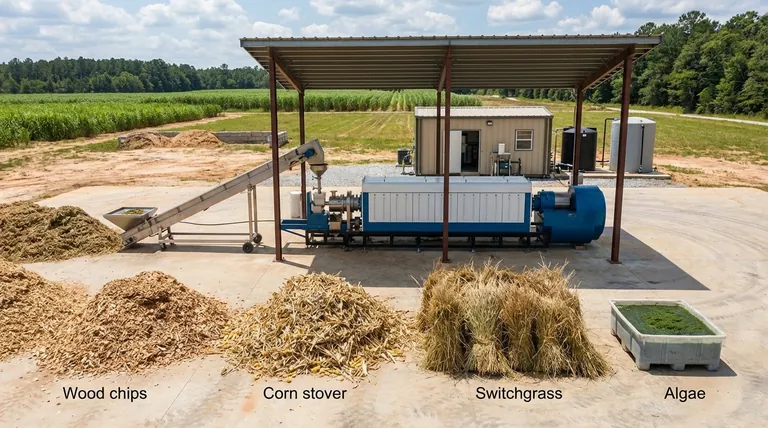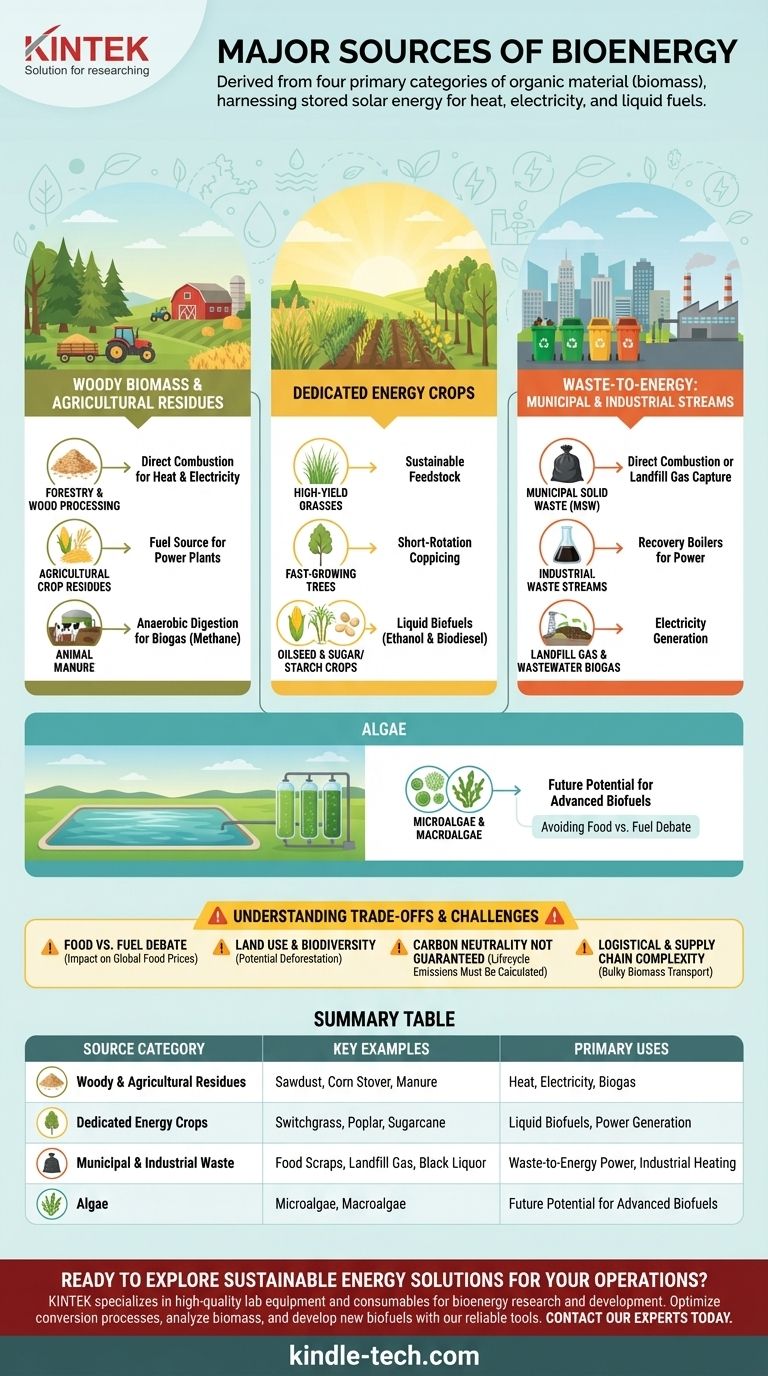The major sources of bioenergy are derived from four primary categories of organic material, or biomass: wood and agricultural residues, dedicated energy crops, municipal and industrial waste, and algae. This organic matter is essentially stored solar energy, captured through photosynthesis, which can be converted into useful heat, electricity, or liquid fuels.
Bioenergy is not a single technology but a diverse field that leverages any recent organic matter as a fuel source. The key distinction between these sources lies in their origin and availability, which in turn dictates the most effective methods for converting them into energy.

The Foundation: Woody Biomass and Agricultural Residues
This category represents the most traditional and widely used form of bioenergy. It focuses on using the byproducts of existing forestry and farming operations, often turning a waste stream into a value stream.
Forestry and Wood Processing Residues
This includes materials from sustainably managed forests, such as forest thinnings, as well as byproducts from industrial wood processing like sawdust, bark, and wood chips. These are typically used in direct combustion to generate heat and electricity for industrial facilities or power grids.
Agricultural Crop Residues
After a food crop is harvested, significant organic material is often left in the field. This includes corn stover (stalks and leaves), wheat straw, and rice husks. Instead of being discarded, these residues can be collected and used as a fuel source.
Animal Manure
Manure from livestock operations is a potent source of bioenergy. It is exceptionally well-suited for a process called anaerobic digestion, where microbes break down the organic matter in an oxygen-free environment to produce biogas (mostly methane), which can be burned to generate electricity and heat.
Purpose-Grown: Dedicated Energy Crops
Unlike residues, dedicated energy crops are grown specifically for their fuel value. These are typically selected for their high yield, rapid growth, and ability to thrive on marginal land not suitable for food production.
High-Yield Grasses
Perennial grasses like switchgrass and miscanthus are prominent examples. They require minimal inputs like fertilizer and water once established and can be harvested annually for many years, making them a sustainable feedstock for power plants or cellulosic ethanol production.
Fast-Growing Trees
Species like poplar and willow can be grown in dense plantations and harvested on short rotations (every 3-7 years). This practice, known as short-rotation coppicing, provides a consistent supply of woody biomass.
Oilseed and Sugar/Starch Crops
This category is the primary source for today's liquid biofuels.
- Sugarcane and corn are fermented to produce ethanol.
- Soybeans, rapeseed (canola), and palm oil are processed to create biodiesel.
Waste-to-Energy: Municipal and Industrial Streams
This approach focuses on capturing the energy embedded within various waste streams, providing a dual benefit of waste management and energy production.
Municipal Solid Waste (MSW)
The organic portion of household and commercial trash—such as paper, cardboard, food scraps, and yard trimmings—can be used as a bioenergy source. This is typically done either through direct combustion in waste-to-energy plants or by capturing methane gas from landfills.
Industrial Waste Streams
Many industries produce organic waste with high energy potential. A classic example is black liquor, a toxic byproduct of the paper and pulp industry, which is now routinely burned in recovery boilers to power the mills themselves.
Landfill Gas and Wastewater Biogas
As organic waste decomposes in landfills or wastewater treatment plants, it naturally produces methane, a powerful greenhouse gas. Modern facilities install systems to capture this gas, preventing its release into the atmosphere and using it to generate electricity.
Understanding the Trade-offs and Challenges
While bioenergy is a critical renewable resource, it is essential to approach it with a clear understanding of its complexities and potential downsides.
The Food vs. Fuel Debate
Using crops like corn and soybeans for fuel can impact global food prices and availability. This is the most significant ethical and economic challenge facing first-generation biofuels.
Land Use and Biodiversity
Clearing land to grow dedicated energy crops can lead to deforestation and habitat loss if not managed with strict sustainability standards. The ideal approach is to use degraded or marginal land that doesn't compete with food or conservation.
Carbon Neutrality Isn't a Guarantee
While burning biomass releases carbon, the idea is that this is offset by the carbon absorbed by the plants as they grew. However, the full lifecycle—including emissions from harvesting, transportation, and processing—must be calculated to determine the true net carbon impact.
Logistical and Supply Chain Complexity
Biomass is often bulky, wet, and geographically dispersed. Unlike dense fossil fuels that are easily transported, gathering sufficient biomass and moving it to a conversion facility can be a major logistical and economic hurdle.
Making the Right Choice for Your Goal
Selecting a bioenergy source is not a one-size-fits-all decision. The optimal choice depends entirely on the specific objective, location, and scale of the project.
- If your primary focus is leveraging existing waste streams: Your best options are agricultural residues, forestry byproducts, landfill gas, and municipal solid waste.
- If your primary focus is producing liquid transportation fuels at scale: Dedicated crops like sugarcane, corn, and oilseeds are the current dominant sources, though their sustainability must be carefully managed.
- If your primary focus is future potential with minimal land-use conflict: Algae represents a promising long-term pathway that avoids the food vs. fuel debate, though it is not yet commercially mature.
Understanding these diverse sources and their associated trade-offs is the first step in harnessing bioenergy responsibly and effectively.
Summary Table:
| Source Category | Key Examples | Primary Uses |
|---|---|---|
| Woody & Agricultural Residues | Sawdust, corn stover, manure | Heat, electricity, biogas (via anaerobic digestion) |
| Dedicated Energy Crops | Switchgrass, poplar, sugarcane | Liquid biofuels (ethanol, biodiesel), power generation |
| Municipal & Industrial Waste | Food scraps, landfill gas, black liquor | Waste-to-energy power, industrial heating |
| Algae | Microalgae, macroalgae | Future potential for advanced biofuels |
Ready to explore sustainable energy solutions for your operations? KINTEK specializes in providing high-quality lab equipment and consumables for bioenergy research and development. Whether you're analyzing biomass composition, optimizing conversion processes, or developing new biofuels, our reliable tools can help you achieve accurate and efficient results. Contact our experts today to discuss how we can support your laboratory's specific needs in the renewable energy sector.
Visual Guide

Related Products
- Electric Rotary Kiln Small Rotary Furnace Biomass Pyrolysis Plant
- Electric Rotary Kiln Continuous Working Small Rotary Furnace Heating Pyrolysis Plant
- Electric Rotary Kiln Small Rotary Furnace for Activated Carbon Regeneration
- Electric Rotary Kiln Pyrolysis Furnace Plant Machine Calciner Small Rotary Kiln Rotating Furnace
- Evaporation Boat for Organic Matter
People Also Ask
- What are the different types of pyrolysis machines? Choose the Right System for Your Output
- What is a disadvantage of biomass energy? The Hidden Environmental and Economic Costs
- What are the conditions for biomass pyrolysis? Optimize Temperature, Heating Rate & Time
- Is pyrolysis viable? A Guide to Economic, Technological, and Environmental Success
- How is energy converted into biomass? Harnessing Nature's Solar Power for Renewable Energy




